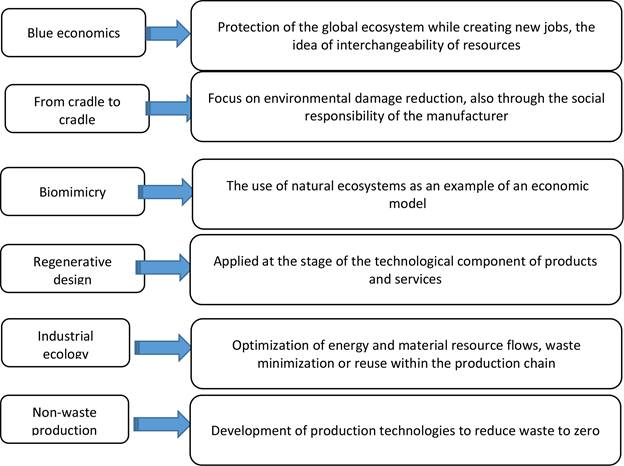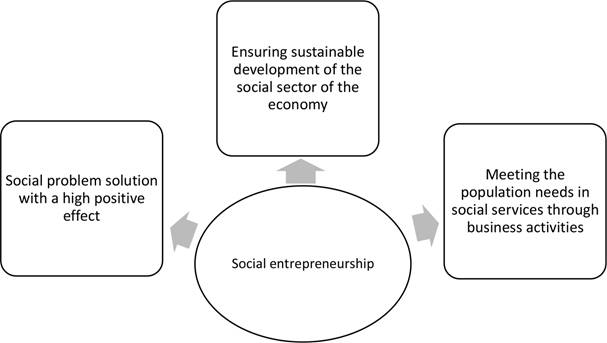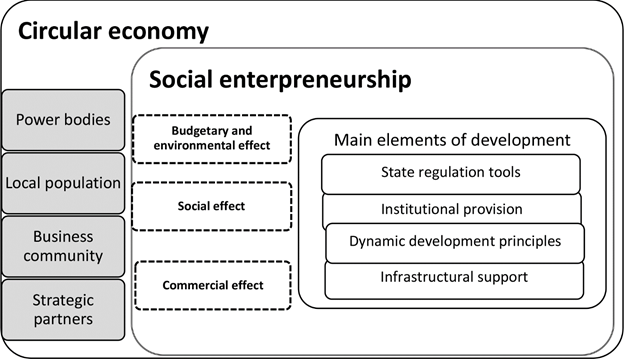Introduction
The current stage of the world economy development is characterized by the fact that the formed economic system, focused on the continuous growth of production level, profit, consumption, leads to the depletion of resources. Over the past year, the issues of accounting for social and environmental consequences are reflected among the leading venues on the world stage. So, during the World Economic Forum in Davos (2020), they discussed for the first time the need for a transition to new ways of economic activity organization and more sustainable approaches to production and consumption, focused on social justice achievement and taking environmental risks into account. In this regard, the key to achieving these goals is the creation and functioning of social entrepreneurship system focused on population social protection and environment preservation.
The effectiveness of social entrepreneurship development is largely determined by the need to create a well-thought-out system of government regulation and support measures, as well as to create a favorable business climate in this area. Its main goal is to create real conditions for the stable development of social entrepreneurship in the country, to integrate existing resources and build specialized organizational structures aimed at the balance of state interests and the interests of social entrepreneurship.
Development
At the same time, the choice of a model for the dynamic development of social enterprises, which makes it possible to achieve efficient use of labor resources and production factors, is of particular importance. In conditions of limited resources, the rational use of existing economic potential is of particular importance, which makes it necessary to transform the established models of economic development. To achieve the dynamic development of social entrepreneurship, the basis for such a transition may be the principles of a circular economy, focused on the renewal of resources and the conservation of the socio-ecological-economic system, which determines the relevance of this study.
Currently, the circular economy includes the following areas, presented on Fig. 1.
Summing up the results of these areas, it can be stated that they are divided into two categories: those that focus on the features of doing business taking into account the achievement of social justice and those that focus more on environmental damage reduction. Therefore, the need for a theoretical and practical compromise between them is important. It is important to develop a socially and environmentally responsible business model that could focus on the principles and values shared by all schools. That is why there is a direct relationship between the principles of the circular economy and social enterprises. In addition to social enterprises, there are other forms of strategic organizational directions, such as corporate social responsibility, but the added value of a social enterprise in its pure form surpasses existing business models in terms of organizational goal / output and results.
In our opinion, during the transition from a linear to a circular economy, the most significant role belongs to social enterprises, whose main mission is not to increase profits, but to achieve socially significant goals. In accordance with the theory of sustainable development, such companies should create a higher added value for society, reduce the negative impact on the environment while satisfying the interests of all parties interested in their activities. However, besides the fact that their activities should be consistent with the goals of sustainable development, it is also necessary to ensure their high efficiency.
In general, two main theories of efficiency can be distinguished in modern economic science: static and dynamic (Huerta de Soto, 2011). The essence of the static theory of efficiency is to maximize results and minimize costs. An abstract criterion of static efficiency is the achievement of the boundary of production capabilities, which, in turn, means the production of the full volume of goods and services that satisfy the maximum of the limitless needs of society, with full employment of all resources already available at a given time period. In contrast, the essence of the dynamic theory of efficiency lies in the discovery and / or creation of new resources of all kinds. From these positions, the abstract criterion of dynamic efficiency is the constant, continuous movement of the production possibilities curve to the right.
Among the supporters considering dynamic efficiency, we should single out such authors as Forrester (2003); Sadovnichy (2012); and Lucas (2013), who believed that the processes of economic dynamics are reflected in a continuous change of economic reality, which allows to conclude that any economic system is dynamic. They did not understand movement by dynamics, since economic systems may not change their spatial boundaries, but a continuous change in the system elements and the relationships between them.
The dynamic and static aspects of economic efficiency were examined in detail by Dolan & Lindsay (2009), in their textbook "Macroeconomics". They determine static and dynamic efficiency from the point of view of proximity to the curve of production capabilities and its shift to the right.
Currently, the most complete and logical approach to the study of dynamic efficiency is the concept by Huerta de Soto (2011), developing the views of representatives of the Austrian economic school. This concept is based on the dominant role of entrepreneurial talent in dynamic efficiency provision of any business entity. According to H. Worth de Soto, the dynamic efficiency of a person, a company, an institution or an economic system as a whole depends on the level of their creative ability for entrepreneurship and coordination.
Thus, when they study the development of complex economic objects, to which entrepreneurship can be attributed, it is advisable to consider static and dynamic efficiency, which in its turn reflect those two aspects of the development process, that can characterize the versatility of entrepreneurship development manifestations.
According to Aray (2018), social entrepreneurs tend to solve acute socio-economic problems caused by the specifics of a particular country or a region. The global scale of distribution, on the one hand, and local specificity, on the other, require the identification of regional trends in social entrepreneurship development. Aray (2018), offers the following definition of social entrepreneurship - it is a break-even entrepreneurial activity, driven by the main mission of the company - the creation of social value - and aimed at society problem solution.
According to Voskolovich (2013), social entrepreneurship in Russian conditions is the compromise between commercial and charitable activities, Social entrepreneurship differs from traditional entrepreneurship and charitable activities by specific social goals - characteristic features of entrepreneurship. Thus, social entrepreneurship occupies an intermediate state between them.
Alexandrov (2014), distinguishes two schools of social entrepreneurship. In the definition of the first school, the scientist includes social organizations aimed at social and financial benefit development as social enterprises, the main characteristics for them are entrepreneurship, innovation and income-generating activities. For the second school - social enterprises as public organizations aimed at social benefit development, but using entrepreneurial methods in management. Zhokhova (2015), invests five different meanings in the definition of social entrepreneurship:
Entrepreneurs are continuously involved in the processes of innovation, adaptation, and training.
Entrepreneurial behavior to implement a social mission and ensure social values.
A process that promotes social change in society.
A model of political transformation - the solution of state problems in the system of social protection.
Entrepreneurial activity to create and form opportunities and solve social and environmental problems.
Summing up, we can distinguish the main contradiction characteristic of social entrepreneurship - the desire to achieve a social mission, on the one hand, and the need to generate income, on the other hand. As the result of this contradiction, other contradictions arise - in combining the sources of financing; in assessing the effectiveness of a social enterprise - the need to evaluate both social and economic efficiency; the need to maintain financial sustainability and the desire to achieve an investment social effect.
Thus, having studied the essence and main characteristics of social entrepreneurship, we can distinguish the functions presented on Fig. 2.
In the conditions of the dynamic development of socially oriented entrepreneurial structures, special attention should be paid to the mechanisms of key stakeholder involvement in the transition to a circular economy, which include government bodies, technology and innovation centers, public associations and the population. Thus, the choice of an optimal model of social entrepreneurship within the framework of existing business methods using the principles of a circular economy is of particular importance.
Fig. 3 presents the model proposed in this study for the dynamic development of social entrepreneurship in a circular economy.
The model consists of interconnected components: a unit of stakeholders - external, to which the population and the state belong, as well as internal - strategic partners and representatives of the business community, consumers; the groups of various effects manifested in the process of interaction; basic elements of development, which include: principles, infrastructural support, state regulation tools, institutional support.
The interaction of stakeholders in the framework of the dynamic development of social entrepreneurship determines the occurrence of certain positive and negative effects in a circular economy. The main ones are presented in table 1.
Table 1 Groups of effects arising from the interaction of stakeholders in the framework of social entrepreneurship dynamic development in a circular economy.
| Effect groups | Interested parties | |||
|---|---|---|---|---|
| Business community | Power bodies | Local population | Strategic partners | |
| Social |
Social responsibility of business Salary level of employees Job creation |
Demographic situation improvement Population life quality improvement |
Availability of qualified personnel Competition in the labor market between the local population and migrants |
Level of scarce and limited resource consumption Use of innovative resource-saving technologies |
| Budgetary-environmental |
Environmental conditions The level of mining |
Monitoring of compliance with labor laws The level of entrepreneurship education program funding |
Level of compliance with consumer protection Ensuring social protection of the population |
Level of environmental behavior CO2 reduction The presence of territories used as a landfill for waste disposal |
| Commercial |
Revenues to budgets of various levels Profit Formation of the final cost of goods Modernization and diversification of production |
Availability of subsidies and grants for business development as the part of support programs for SME The level of business infrastructure development |
Unmotivated local population in work obtaining issues Interaction with public organizations |
The costs of warehouses and land for waste storage maintenance, as well as environmental taxes Demand for secondary material resources |
Thus, by strengthening interaction, the state receives the effect of the environment state improvement, reducing the level of mining, reducing unemployment, increasing tax revenues to the budgets of various levels, and reducing the territories used as a landfill for waste disposal. In general, a positive effect on the state economy can be expressed in resource-intensive industry share decrease, and in import substitution increase. The introduction of the indicated model will entail improved health for the population, due to soil, air and water pollution reduction, the reduction in unemployment, and the demographic situation improvement.
The positive effect for the business community is to save on the secondary use of resources, as entrepreneurial structures gain the ability to use innovative resource-saving technologies. At the same time, in order to ensure the introduction of a circular economy, it is necessary to ensure economic returns from the population as consumers closing the product production cycle. It is the system of preferences and bonuses offered to customers for the return of used products that determines the possibility of product disposal, and the possibility of moving to the next stage of the life cycle. This should be ensured by a certain environmental management system of manufacturing enterprises.
To implement this model, government bodies must ensure the provision of certain institutional and infrastructural support to the subjects of social entrepreneurship:
The introduction of benefits in the implementation of waste reduction technologies.
The introduction of an environmental tax on the territory of the Russian Federation paid by the producer of goods to waste management organizations.
A phased prohibition on the disposal of waste, which includes useful components to be disposed of modernization of the existing infrastructure for the collection and treatment of waste, and the creation of almost zero cycle infrastructure for their disposal on an industrial scale.
Acceleration and popularization of social entrepreneurship.
Conclusions
The instruments of state regulation include financial instruments, which include the provision of subsidies, budget investments, state and municipal guarantees for the obligations of SMEs and the organizations that form SME support infrastructure. Non-financial instruments can be implemented in the form of training for entrepreneurs and SME employees, providing premises on favorable terms, consulting support, etc.
It is worth noting that the influence of state regulation tools and the whole block of development elements will be differentiated significantly depending on regional specifics.
Thus, in the framework of a circular economy concept, the determining factor of its development is the long-term effect of social entrepreneurship, which consists in a favorable environment maintenance, natural resource renewal while reproducing human capital and achieving social justice.

















